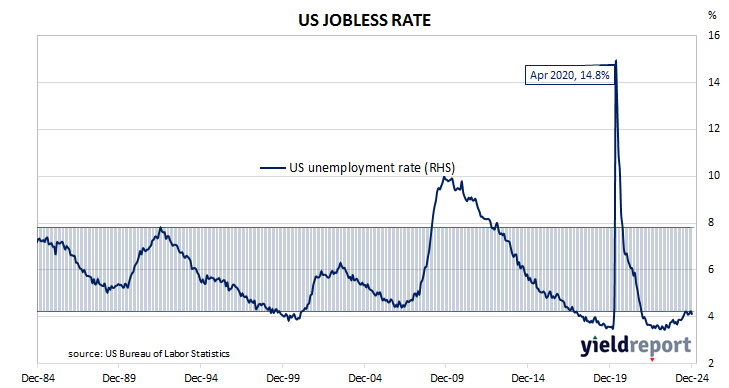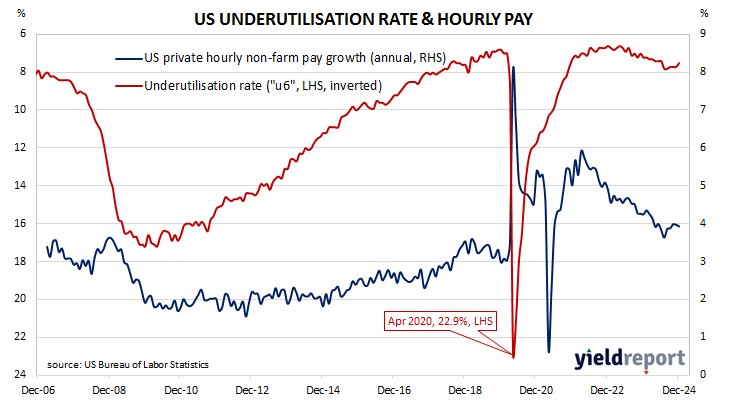Summary: US non-farm payrolls up 256,000 in December, above expectations; previous two months’ figures revised down by 8,000; jobless rate ticks down to 4.1%, participation rate steady at 62.5%; Westpac: Dec quarter increase in payrolls exceeds Sep, June quarters; US Treasury yields rise; expectations of Fed rate cuts soften; ANZ: labour market weakness previously expected has not materialised; employed-to-population ratio rises to 60.0%; underutilisation rate falls to 7.5%; annual hourly pay growth slows to 3.9%.
The US economy ceased producing jobs in net terms as infection controls began to be implemented in March 2020. The unemployment rate had been around 3.5% but that changed as job losses began to surge through March and April of 2020. The May 2020 non-farm employment report represented a turning point and subsequent months provided substantial employment gains which have continued to the present.
According to the US Bureau of Labor Statistics, the US economy created an additional 256,000 jobs in the non-farm sector in December. The increase was greater than the 165,000 rise which had been generally expected as well as the 212,000 jobs which had been added in November after revisions. Employment figures for October and November were revised down by a total of 8,000.
The total number of unemployed decreased by 235,000 to 6.886 million while the total number of people who were either employed or looking for work increased by 243,000 to 168.547 million. These changes led to the US unemployment rate ticking down from 4.2% in November to 4.1%. The participation rate remained unchanged at 62.5%.
“Some volatility and catch-up are almost certainly at play given weather-related events through the December quarter,” said Westpac economist Jameson Coombs. “That said, payrolls averaged 170,000 per month through the quarter, up from almost 160,000 in the September quarter and near 150,000 in the June quarter. The trend suggesting a stabilisation and possible re-firming in labour market conditions over the back half of 2024.”
Short-term US Treasury bond yields jumped on the day while longer-term yields rose by more moderate amounts. By the close of business, the 2-year yield had gained 12bps to 4.38%, the 10-year yield had added 7bps to 4.76% while the 30-year yield finished 2bps higher at 4.95%.
In terms of US Fed policy, expectations of a lower federal funds rate in the next 12 months softened, although another 25bp cut is still currently priced in. At the close of business, contracts implied the effective federal funds rate would average 4.32% in February, 4.30% in March and 4.265% in April. December 2025 contracts implied 4.065%, 27bps less than the current rate.
“When the Fed cut rates [by] 50bps in September, it feared the labour market could be on the cusp of weakening in an accelerating fashion,” ANZ FX analyst Felix Ryan observed. “That has not materialised and current strength in service sector activity suggests it is unlikely to anytime soon. The labour market is signalling that the FOMC can be patient in its considerations over the future path of policy.”
One figure which is indicative of the spare capacity of the US employment market is the employment-to-population ratio. This ratio is simply the number of people in work divided by the total US population. It hit a cyclical-low of 58.2 in October 2010 before slowly recovering to just above 61% in early 2020. December’s reading rose 0.2 percentage points to 60.0%, still considerably below the April 2000 peak reading of 64.7%.
Another measure of tightness in the labour market is the underutilisation rate, which declined from 7.7% to 7.5% in November. Wage inflation and the underutilisation rate have an inverse relationship over time but not necessarily from month to month. Private hourly pay growth in the year to December slipped from 4.0% to 3.9%.



